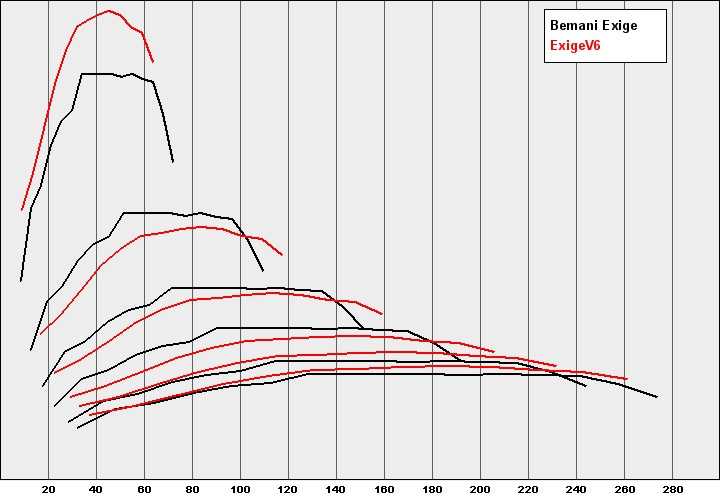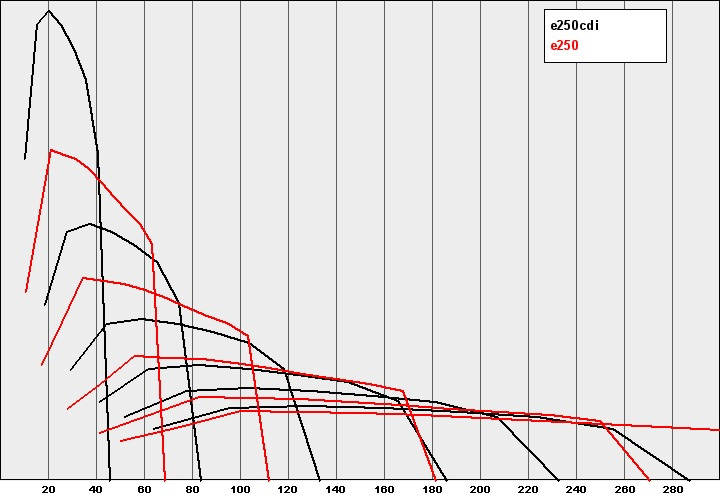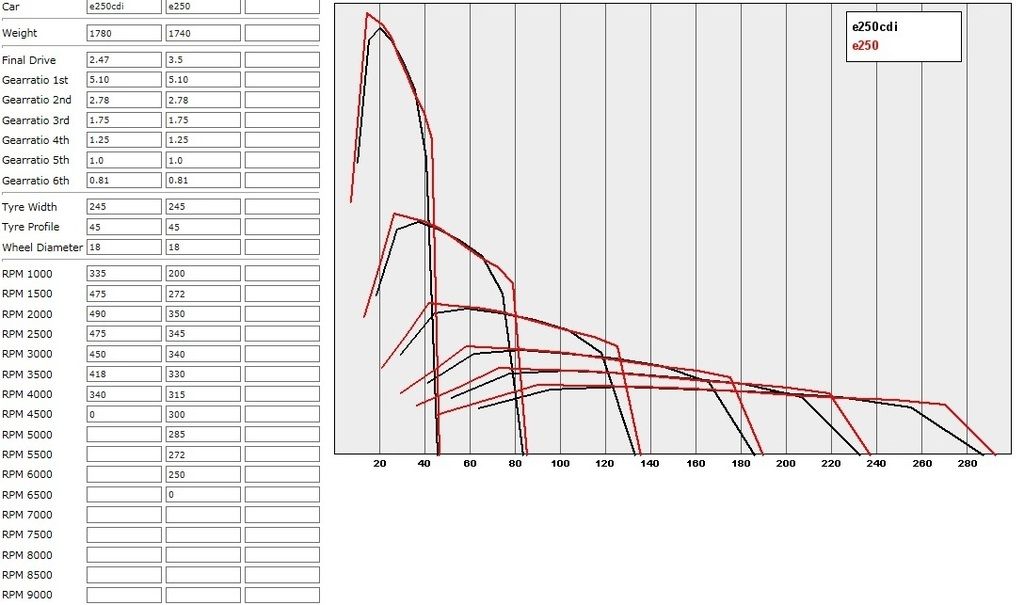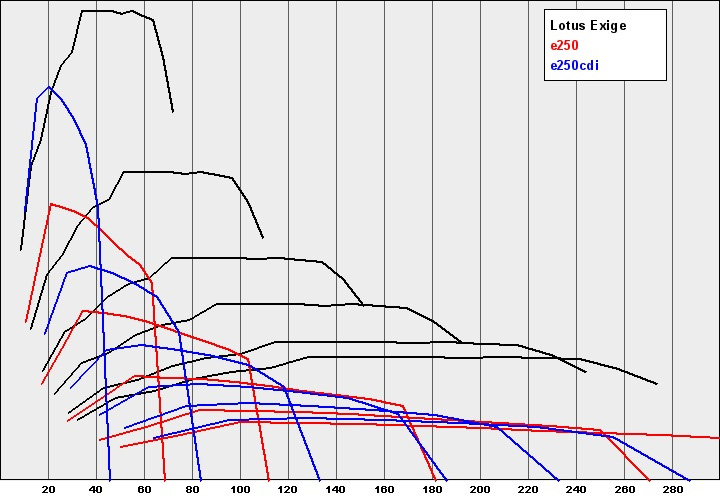It's energy, dammit!FoxHound wrote:Can we all agree torque is invisible?
- Login or Register
No account yet? Sign up
It's energy, dammit!FoxHound wrote:Can we all agree torque is invisible?



Code: Select all
e250cdi (diesel) e250 cgi (petrol)
-----------------------------------------------------------
final drive: 2.47 3.07
1st: 5.10 3.95
2nd: 2.78 2.42
3rd: 1.75 1.49
4th: 1.25 1.00
5th: 1.00 0.83
6th: 0.81
-----------------------------------------------------------
Interesting stuff! This is a great effort, and I hope you don't mind a couple of comments: At speeds below 45 km/h I would think that wheel spin/traction is likely to be the limiting factor of the car's acceleration, so the force advantage of the diesel engine in first gear isn't necessarily real, at least not until approaching 45 km/h. At 45 km/h, the engine is capable of an acceleration higher 0.6 g and I am not sure if the tires are capable of much more.Phil wrote:What this shows us, is that the diesel car (black) has a lot more force at the wheel in 1st gear up to the drop off point at around 45km/h. That would be at close to max rev on the diesel (4000rpm). At that point, the petrol e250 is only at midrange of its rpm range and continues to rev until it hits 70km/h. From 45km/h to 70km/h it is quicker, because in the Diesel, you will already be in 2nd gear where higher friction through the transmission will see less force at the wheel.
The chart from your link is the be-all and end-all of the discussion:-Phil wrote: I know what you mean with the final gear. If the final gear is 3.5 in the petrol car and all other gears remain identical to each other, the graph is nigh on match. That is only because the petrol and diesel engine have very similar curves, just spread over a slightly wider rev-range in the petrol.

Thanks! Yeah, traction limit is probably a big issue. But it's hard to quantify (different tyre compound or surface grip could offset how much force you can apply before the wheels spin). Even drag too. In reality, you would need to account for traction and at higher speed the drag coefficient that would lead to an overal reduction in force as you gain speed, but progressively more air resistance. I find the graph great though for comparing in-gear acceleration between different cars. It's easy to see where which car at which rev-range and gear would have an advantage or not.Stradivarius wrote:Interesting stuff! This is a great effort, and I hope you don't mind a couple of comments: At speeds below 45 km/h I would think that wheel spin/traction is likely to be the limiting factor of the car's acceleration, so the force advantage of the diesel engine in first gear isn't necessarily real, at least not until approaching 45 km/h. At 45 km/h, the engine is capable of an acceleration higher 0.6 g and I am not sure if the tires are capable of much more.
Yeah. What I ment with friction is what you just explained.Stradivarius wrote:By the way, you write that from 45 km/h to 70 km/h, the petrol car is quicker because the diesel car is already in 2nd gear. This is correct, but it has nothing to do with friction. As far as I can understand, your calculations don't even account for friction. The reason why the diesel has less force in 2nd gear is the simple fact that a higher gear (exchange ratio) is trading torque for rotational velocity. So even though the engine torque actually is higher right after shifting to 2nd gear compared to right before the gear shift, the torque on the wheels is smaller due to the gear exchange ratio. This is why I think it's more convenient to forget about the torque and instead consider the power. Then you directly see the exact reason why the force drops when shifting to a higher gear: The engine power drops because you move to an engine rpm range with less power. Additionally, the force always decreases as the speed increases due to the simple equation: Power = force x speed.

The rev range is the key to the power "feel" - the diesel generate almost 50% more power at 2000rpm (this is the "low-end torque" which is actually low-end power and the root cause/ root-of-all-evil for all the power vs torque discussions). Change the scale on the x-axis and you'd see engines with very different characteristics. This is also the main advantage of the diesel - more power at a lower rpm means better fuel efficiency, and makes it better for pulling tasks to boot (you need to get the rpms up and let the clutch slip to get a heavy trailer moving). Based on those reasons I would always take a car with the power max at the lower rpm, unless the power deficit is too large.machin wrote:Both cars have the same 7 speed gearbox: only the final drive ratios are adjusted to account for the different rev ranges of the two cars... if you re-do the charts based on that it will be very telling why the performance of the two cars is very similar....
I don't think it is necessary to start estimating the grip based on data such as tire compound, surface parameters and temperatures. These are two almost identical cars with different engines, so I guess it's safe to assume they have similar traction. My point was merely that in 1st gear, the engine is not the limiting factor and the engine performance is thus not interesting when considering 1st gear performance. At least not for the diesel engine as it seems to have very low exchange ratio in 1st gear. The petrol engine probably becomes the limiting factor before changing to 2nd gear, as this won't happen until the speed is around 70 km/h. But unless the cars have different traction, there is no reason why they won't perform equal at low speeds, let's say below 40 km/h.Phil wrote:Thanks! Yeah, traction limit is probably a big issue. But it's hard to quantify (different tyre compound or surface grip could offset how much force you can apply before the wheels spin). Even drag too. In reality, you would need to account for traction and at higher speed the drag coefficient that would lead to an overal reduction in force as you gain speed, but progressively more air resistance. I find the graph great though for comparing in-gear acceleration between different cars. It's easy to see where which car at which rev-range and gear would have an advantage or not.Stradivarius wrote:Interesting stuff! This is a great effort, and I hope you don't mind a couple of comments: At speeds below 45 km/h I would think that wheel spin/traction is likely to be the limiting factor of the car's acceleration, so the force advantage of the diesel engine in first gear isn't necessarily real, at least not until approaching 45 km/h. At 45 km/h, the engine is capable of an acceleration higher 0.6 g and I am not sure if the tires are capable of much more.
It is a valid and important point that diesel engines have better fuel efficiency in everyday use. When you don't want full power from a petrol engine, you use the throttle, to restrict the intake to the cylinder, which causes an energy loss not seen in diesel engines because they directly limit the amount of fuel going into the cylinder. So on partial loading, diesel engines are more efficient, but I don't follow you when you say they are better for pulling tasks. It is true that the clutch on a diesel car works at smaller rpm, but it also transfers a higher torque when comparing to a petrol engine, so I don't understand why one would be any better than the other.CBeck113 wrote: The rev range is the key to the power "feel" - the diesel generate almost 50% more power at 2000rpm (this is the "low-end torque" which is actually low-end power and the root cause/ root-of-all-evil for all the power vs torque discussions). Change the scale on the x-axis and you'd see engines with very different characteristics. This is also the main advantage of the diesel - more power at a lower rpm means better fuel efficiency, and makes it better for pulling tasks to boot (you need to get the rpms up and let the clutch slip to get a heavy trailer moving). Based on those reasons I would always take a car with the power max at the lower rpm, unless the power deficit is too large.
Be careful of falling into the trap of paying too much attention to the rpm numbers. I work for a Diesel engine manufacturer and some of our engines only rev to 1300rpm FLAT OUT.... which is about idle speed on some automotive petrol engines, and nowhere near idle on a gas turbine engine.... So it is wrong to say that 2000rpm is the "low end" in every case... in the Merc example above 2000rpm is actually 50% of max.... whereas 2000 rpm on the petrol is only 30% of max. We're conditioned to think that 2000rpm is "low"... but only because the majority of us drive around in petrol engined cars with 6000-7000rpm red lines.CBeck113 wrote: The rev range is the key to the power "feel" - the diesel generate almost 50% more power at 2000rpm (this is the "low-end torque" which is actually low-end power and the root cause/ root-of-all-evil for all the power vs torque discussions).
if you couldn't hear the engine and didn't have a rev counter it might not be so easystrad wrote:J.A.W.'s post sums it up better than most any in this thread.
Anyone that thinks you can drive a diesel or a petrol engine and not feel the difference is out in left field. imo